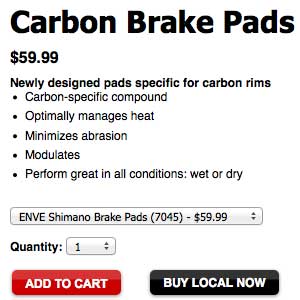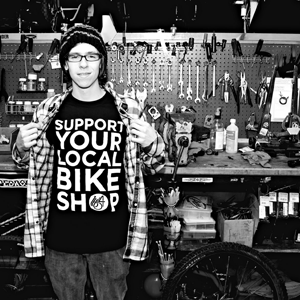A Bike Seller’s options

In a prior installment I wrote about Bad Amazon and Good Amazon. To be clear, Amazon is only bad, sez me, when it erodes the lattice-like structure of specialty stores. Amazon’s problem is that it doesn’t, in my view, see the future, and neither do those brands who sell to it, unless those brands sell commodity goods.
If you’re TYR, Speedo, Zensah, Pearl Izumi, 2XU, Orca, De Soto, Zoot, blueseventy, Aquasphere, you’re among the top tier brands in triathlon’s soft goods industry. Most of these brands sell directly to Amazon. In some cases, they sell to Amazon as a form of advertising — they’re using Amazon in order to expand their reach and tell their stories. In fact, I predict the day will come when Amazon suffers from “reverse showrooming”: customers using Amazon’s user reviews prior to obtaining a product via some other channel. (More on showrooming later.)
Bad Amazon is bad when it approaches a vendor directly and, in my view, unethically — not breaking any agreement, but certainly breaking any common understanding of trust with its “partner” retailers. But it’s not bad behavior that concerns me. Companies behave badly all the time. My concern is that this is ultimately bad for every stakeholder in cycling, running and triathlon, because of the arc of the cycle this behavior begets. As the good brands get picked off by Amazon, one by one, specialty stores suffer and, ultimately, face failure. Without this lattice of specialty stores, Amazon, Sports Authority, Costco, Dicks Sporting Goods, don’t know what to buy — they can buy commodities, but there's no front line brand builders to introduce a product to a consumer at the local level. Amazon is not going to place a big order with a specialty brand if there is not that network of specialty stores making that brand hot.
Brands who sell to Amazon will, one by one, begin to realize this. The question is whether they’ll do so before they find that Amazon is 60 percent of their business, and there’s no chain of specialty stores to go back to.
This is why the first question asked by a wise and prudent buyer from a premier specialty store, when approached by a new hot brand is, “What is your online strategy?” To the brand managers reading this, I’ll tell you how to answer that question before the series terminates.
Good Amazon is the aggregator of specialty stores around the planet into a virtual warehouse. This is amazing technology. Imagine that you are a seller of 2XU, and you have their very popular compression wear. A non-stirrup calf guard comes in 8 sizes and 5 colors. That’s 40 SKUs. Do you have 40 SKUs in stock? Times a couple of size runs in their popular SKUs? Do you also carry Zensah? That’s a lot of inventory in compression wear. You probably have holes in your inventory.
Here’s where Amazon’s magic is evident. You are part of a virtual warehouse, and it may well be that none of the individual constituents of that warehouse are comprehensive in their inventories. But in the aggregate you are!
This solves one of the primary complaints of those who resort to mail order, and to Amazon in particular: I would certainly buy an item from my LBS, if my LBS had it!
Vendor Link
Let us stipulate that a particular shop does endeavor to service the triathlon community. This shop, and its vendors, has access to information through technology that has made Amazon the behemoth it is today. Vendor Link is one of three enterprises that I’ll write about today that utilizes an API that sits on a retail stores point-of-sale (POS) software.
Something close to 90 percent of bike shops today use POS software. Major bike suppliers either own or champion particular POS versions. Trek’s POS software of choice is Ascend. Also popular is MerchantOS. There is Retail Star, Edge, Microsoft RMS, Celerant, CashierLive, LightSpeed — altogether I know of 17 POS platforms bike stores use and I’m sure there are many more. A very good API can scrub the inventories of each bike shop, irrespective of the POS software used. Obviously some handshaking is required, and the best among these APIs scrub inventories of 10 of the most popular POS packages.
As far as I can tell Vendor Link was built, originally, as a forecasting tool. Imagine you make floor pumps. You want to know what the state of floor pump inventory and sales is in North America. Yes, you know how many floor pumps you sold. But you don’t know what your contemporaries’ sales were, and you don’t know the sell-through, even of your own pumps. Vendor Link gives you real-time access to inventories, and demonstrates trends per however you want to query that common database of sales records.
At some point, a light bulb went off in somebody’s head — at least it seems to me — and the folks at Vendor Link realized they had technology fairly analogous to Amazon’s. So, why not deploy this technology on the front end, where consumers can see and use it? Why not use this technology to, like Amazon, turn local bike shops into a national network that constitutes a virtual warehouse?
If consumers had access to the same data that vendors have, rather than being disappointed by their local bike shops’ lack of inventories, consumers could check those inventories. If I live in Chicago, and Cozy’s doesn’t have a latex tube, maybe EndureIt! does. If Gregg’s Bellevue in greater Seattle doesn’t have it maybe Speedy Reedy does.
Vendor Link’s outreach to the end user is called, “at my Local Bike Shop” and it’s really powered by participating bike shops, more than brands. As of now, there are upwards of 600 shops participating. Consumers can go to at my Local Bike Shop and give it a whirl.
The problem is the space between theory and execution. I tried to buy a latex tube anywhere in the Los Angeles area. No dice. As a test, I went to Google and searched “latex bicycle tube Los Angeles.” Know what came up first? A thread on the Slowtwitch forum entitled Buying Latex Tubes during which the OP chronicled his frustration, and helpful Slowtwitchers advised… Amazon. As well as Competitive Cyclist, ProBikeKit, and the other usual suspects.

Buy Local Now
A lot of retailers in the bike biz rely on an outfit called Smart Etailing. This company presents website and ecommerce solutions to local bike shops, and you might think this oxymoronic, however, I went to buy a set of carbon brake shoes from the CycleOps website, and what I found is pictured adjacent. I can either buy this from CycleOps, or I can buy it at any of a number of local shops. If I do choose this avenue, I’m instructed to purchase the item on the local retailer’s ecommerce site, and then pick up the item will-call. This opens up a world of options, which we’ll discuss in a further installment.
Buy Local Now’s problem is that there is a dearth of vendors, and vendors are the platform of execution chosen by Smart Etailing. The only way this service works is through the vendor website, that is, there’s no stand-alone shoppable site. You go to a vendor’s site, you click the Buy Local Now button below the item in which you’re interested, you’re migrated to the retailer of your choice who’s selling that item locally. This is great technology. It looks great. It works. There just needs to be more vendors. And, of course, there’s the problem of inventory. In point of fact, there are dozens of retailers that sold, theoretically, that carbon brake pad. But none had it in stock. So, I could buy it from CycleOps directly. But Buy Local Now could not offer the product through a specialty bike retailer from the next county over who might agree to sell me the item mail order.
Shopatron
This is not a service specific to the bike industry. But the technology is similar to the two examples above. If inventories are known and housed, and are searchable, then manufacturers can deploy local retailers as point of service through multiple channels. Simply put, both the Buy Local Now and at my Local Bike Shop suffer from what seems to me an unfortunate concern: that local bike shops are so skin sensitive to mail order, the idea in general is sufficiently unpalatable so as to foreclose any channel that involves shipping.
Shopatron is not so-encumbered in its thinking. It invites any and all channels: in-store pick-up, local shipping, mail order, you name it. The idea is to place a selling opportunity in front of a set of retailers, and that retailer who wants that sale, and is deemed most fit to service the consumer is blessed with that opportunity. However, it seems to me, unless I misunderstand that process, there is some lag between a consumer placing the order and the time Shopatron sifts through the options and designates a seller.
Who Executes Best?
The point of this installment is to set the table for an analysis of what the landscape might look like in the future, for all stakeholders. As of now, Amazon executes best. No newsflash there. In all three examples above, the technology exists, and is deployable, and is no longer a black art only known to Amazon and a very few companies like it. However, Amazon remains by far the most comprehensive, seamless user of this technology, and has a unique ability to make its partner stores execute to a high service standard.
However, think about what Amazon can’t do. You can’t get your Amazon product today; in an hour; in a half-hour. You can’t sniff it before you buy it. Amazon might have a lot of partner stores, but not nearly as many as Buy Local Now or at my Local Bike Shop. Amazon can’t allow you the option of channels the way Shopatron can. Amazon has not nearly the aggregation of product information necessary to be a complete solution. Amazon is there for you if you don’t need anything beyond the acquisition of a product, and Amazon is not there for you if you need something — like a bicycle — that vendors just won’t allow to be sold online.
In other words, all these entities we’ve touched on represent partial solutions. In our next installment we’ll imagine what might be, and we’ll talk about what some retailers are doing now.



